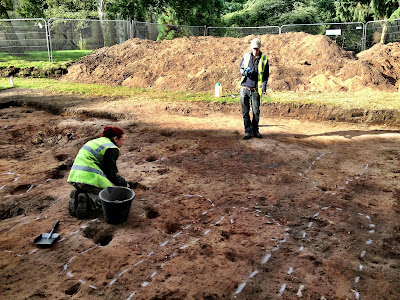Over the past week, our volunteers have been working extremely hard. We've removed all of the topsoil from the area using mattocks and shovels. There's been a real mix of finds from the topsoil: we've found everything from this beautiful piece of prehistoric worked flint...
 |
| Prehistoric flint flake discovered within the topsoil |
... to fragments of 20th century vinyl records. That's a date range of over 3000 years! To find such a variety of material within topsoil isn't unusual - topsoil is inevitably disturbed by roots, burrowing, landscaping and dumping of material, hence why artefacts from earlier, deeper deposits sometimes end up in the upper layers. Another process which will have brought older material close to the surface is the digging of graves within the churchyard.
 |
| Another star find: lovely writing stylus, perhaps dropped by a careless schoolchild... |
As we mentioned in the last post, we have a poignant reminder of the fact that this used to be a burial ground in the fragments of headstones discovered lying loose and broken within the topsoil. On many, the writing is still legible, and after cleaning we've even been able to make out a few names.
 |
| Volunteer Beckie excavating a cluster of headstone fragments |
 |
| Fragment of a very fine memorial stone |
Once we'd finished removing the topsoil, we set about giving the area a thorough 'trowel clean'. If you followed the progress of our DigBromsgrove project, you'll have heard us wax lyrical about 'cleaning'. If not, and if you've been puzzled by the sight of lines of our volunteers on their knees dutifully scraping away at the soil with tiny trowels, we'd like to reassure you that it's not a sadistic punishment! In fact, it's crucial to identifying any archaeological features that might exist within, or 'cutting' into, a layer. We like to compare it to sanding a block of old wood - by carefully removing a thin slice, you expose the grain underneath. Likewise, a good trowel clean 'brings out' any changes in soil colour or texture that betray the presence of archaeological features.
 |
| Trowel-cleaning |
In this case, the 'features' we're expecting to find at this level are graves - there's still a bit of soil to shift before we see any trace of the possible minster! We're trying to identify how many graves are within our area, whereabouts they are in relation to the possible building shown on the geophysics plot, and whether there's anything left of the occupants of the graves. Although the last burial in the churchyard was only around 150 years ago, bone degrades very quickly in sandy, acid soils, and many of the loose bone fragments we're coming across are little more than stains in the sand, crumbling to dust as we carefully extract them.
We want to locate any graves as accurately as possible because, if there's anything left of the remains interred within, we'll try to avoid disturbing them by going around them as we dig deeper. However, the graves have been tricky to locate. This is not uncommon, as graves don't tend to be left open for long, and the soil that comes out goes back in very quickly, so they can leave very little trace. The sunny weather and quickly drying soil doesn't help visibility, so we've been spraying the trowel-cleaned areas with water to make the subtle outlines of the features more visible.
 |
| Project Officer Andy Walsh sprays the cleaned areas with water. The white lines mark features, identified through changes in soil colour and texture. Archaeologist Ruth Humphreys is excavating a small trial hole to check the profile of the feature. It's rectangular in shape, with vertical sides - the typical profile of a grave. |
Once we've identified all of the features within an area, the volunteers got to work producing the 'pre-excavation plan', a carefully measured scale drawing of the area tied-in to a grid set out across the site. This will help us to determine which areas we can target to excavate deeper, and hopefully locate the source of the tantalising geophysics!
 |
| Producing the scale 'plan' |
If you'd like to see the site, find out more about what we're up to and why we're doing it, see some of the finds and talk to the archaeologists and volunteers, come along to our Open Day this Saturday 7th September. We'll be there from 10:00 until 16:00. The postcode is DY10 2JN, and there is parking available in the public car park next to the Church. All ages are welcome. We look forward to seeing you then!
Rob Hedge







No comments:
Post a Comment